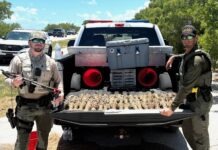
They’re just not here.
The giant swallowtail butterfly, once a common sight flitting amid fragrant gardens, has been noticeably absent since Hurricane Irma battered the Keys in September 2017.
“To be clear, we’re not saying the giant swallowtail is extinct, or even endangered,” said Sam Trophia, founder of the Trophia Butterfly Foundation and co-owner of the Key West Butterfly & Nature Conservatory. “They’re still plentiful in other places. But they’ve been noticeably absent from Key West since Irma, and we want to bring them back.”
The foundation has a plan to do just that.
“But we need the Key West community to help,” said Clarisa Fluker, foundation board member and conservatory employee who’s been working with Trophia and others on a plan to reintroduce the giant swallowtail to Key West.
While the giant swallowtail feeds on the nectar of flowering plants, Fluker explained, it lays its eggs on the new-growth leaves of citrus, particularly Key lime, trees.
The caterpillars that emerge from those eggs construct a chrysalis that conceals them during their metamorphosis. (A butterfly emerges from a chrysalis; a moth emerges from a cocoon.)
“We lost a lot of Key lime trees in Hurricane Irma because they’re not salt-tolerant,” said Trophia, “and in the years before the hurricane, the threat of citrus canker kept many people from planting Key lime and other citrus plants.”
In order to encourage the return of the giant swallowtail, the foundation on March 21 will give away 300 Key lime trees — plus a decorative pot — to supporters of the project.
“We’ll start at 10 a.m. on Saturday, March 21 at the MARC plant store,” Trophia said. “It’ll be first come, first served, one tree per household until all 300 are gone.”
He added that Key lime recipients will be asked to provide the street address where the potted Key lime tree will be planted.

The address is needed, Trophia said, so his team can map the locations of the potted Key lime trees.
“In addition to buying the Key lime trees to give away, we’ve also ordered 1,000 giant swallowtail pupae,” Trophia said. “We’ll care for those until they hatch as butterflies, then we’ll release batches of live butterflies in the vicinity of the Key lime trees.Our hope is that the butterflies will find the citrus trees, lay their eggs on them and thus bring the giant swallowtail butterfly population back to Key West.”
If the plan is successful, the team will do the same thing on neighboring islands, Fluker said.
Trophia said they’re providing the decorative pots so supporters will plant the Key lime tree in a pot rather than the ground, to ensure the tree can be placed in direct sunlight.
“Due to the thorny nature of Key lime and other citrus trees, the city of Key West can’t use them in public plantings,” Trophia said. “That’s why we need the help of individuals.”
He acknowledged that hungry caterpillars can devour the leaves of a Key lime tree, “but we’re hoping some folks will choose butterflies over Key limes, or perhaps consider planting multiple Key lime trees.”
Fluker added that the butterflies feed on nectar from flowering plants, which will be available from the MARC nursery during the March 21 tree giveaway.
“We’ll provide all the information people need to make this a success,” Trophia said, adding that pesticides can harm or kill hatching butterflies, and pruning of Key lime trees will ensure the emergence of new growth leaves on which butterflies prefer to lay their eggs.
For more information about the all-volunteer foundation, which has donated more than $200,000 worth of trees to the city of Key West and installed dozens of butterfly gardens, go to trophiabutterflyfoundation.org or find them on Facebook.























